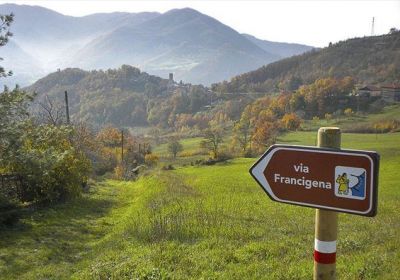After seemingly endless debates and changes in leadership, the UK was scheduled to formally withdraw from the EU on January 31, 2020 [at press time], triggering a transition period that will last until December 31, 2020, during which time certain outstanding issues must be resolved. One of these issues is the freedom of movement throughout Europe and the UK: one of the EU’s most popular benefits, particularly among young people. This mobility has roots that go back to the beginnings of Christianity, as the concept of Western Europe was beginning to develop, and there is no better symbol of this connection than the pilgrimage route known as the Via Francigena.
Stretching 1,600 km from Canterbury Cathedral to Rome, this road represented much more than a journey of faith, rather, it was a way in which people from across the continent could exchange not only goods, but also customs, languages and culture.
All Roads Lead to Rome
The backbone of the Via Francigena was the trade route opened by Julius Caesar in 58 BC, known as the “Road of the Sun,” a direct route between the North Sea and Rome. It was one of the consular roads of the Roman Empire, serving both economic, military and administrative purposes. After the fall of the Empire, these ancient roads fell into disuse. Then, in the Early Middle Ages, the Longobards began using sections of the old Roman road to connect their kingdom based in Pavia with the duchies to the south, when it was known as Mons Longabardum and later Strada di Monte Bardone. When their territory was conquered by the Franks, the name changed to the Iter Francorum, or Via Francisca, and it became the principal route connecting Northern and Southern Europe. The first reference to its current name, Via Francigena (VF), “the road that comes from France,” appears in a parchment from 876 that is stored in a Tuscan abbey.
Sigeric the Serious
Christians began making pilgrimages to the Holy Land in the 3rd and 4th century, visiting sites connected with the life of Christ. But, when Jerusalem fell to Muslim domination in 640 AD, these journeys became much more difficult. Christians then began to demonstrate their faith by travelling to Santiago de Compostela along the “Way of St. James,” and to the tombs of Saints Peter and Paul in Rome.
At this time, the VF was actually a series of different routes which varied depending on the time of year, political situation and popularity of shrines and cathedrals along the way. Travelers would have entered Italy using one of three or four crossings through the Alps.
It was the journey of Sigeric the Serious to Rome that defined the route as we currently know it. Sigeric made the obligatory pilgrimage to Rome to receive his pallium, an ecclesiastical vestment decorated with the sign of the cross. He arrived in Rome in July, after a two-month journey, but did not linger in the ancient city. In a whirlwind visit, he was received by Pope John XV and visited 23 churches in just three days before starting back to England. The detailed diary he kept of his journey home, noting the location of 80 “mansions” or resting places, became a guide for other pilgrims, although, of course, printing had not yet been invented so the information was exchanged by word of mouth.
It wasn’t until Pope Boniface VIII announced the first Jubilee Year, or Holy Year, in 1300 that the tradition of making a pilgrimage truly began to flourish. The pope promised forgiveness of all sins for anyone who visited the basilicas of Saint Peter and Saint Paul more than 15 times (30 if you were a resident of Rome).
Pilgrims were almost exclusively men. Women undertaking such a journey would have been viewed in an overwhelmingly negative light (think Alyson, the Wife of Bath in Chaucer’s “Canterbury Tales”) even if they could have gotten the necessary permission from husbands and fathers. However, Margery Kempe proved to be one of the few exceptions. She was an English Christian mystic who narrated (or rather dictated, as she was illiterate) her pilgrimages and divine experiences in “The Book of Margery Kempe,” considered the first autobiography in the English language. Daughter of a well-to-do merchant, she married and had 14 children before she set out on a pilgrimage to the Holy Land in 1413, stopping in Venice and Rome along the way. In 1417, she made the journey to Santiago de Compostela. Later, after she became a widow, she travelled to many holy sites throughout Europe.
Faith and Commerce
The VF was not only used to demonstrate faith. Over the centuries, it played an increasingly important role in trade, an extension of the Silk Road that brought spices and other precious goods from the East. However, as trade expanded, a number of other variants began to develop, with routes that connected cities and ports rather than cathedrals and monasteries. As the Renaissance bloomed, Italian roads tended to focus on Florence, which had become Italy’s artistic, intellectual and commercial hub.
By the 16th century, the Via Francigena had been essentially forgotten. Then, in 1985, Giovanni Caselli, a Tuscan anthropologist and adventurer who had already hiked the Silk Road, stumbled upon records of the old pilgrimage route and decided to travel Sigeric’s journey. His book garnered renewed interest and led to the VF’s designation in 1994 as a Council of Europe Cultural Route and it has been submitted for consideration as a UNESCO World Heritage Site. In 2007, a 0-km milestone was laid outside Canterbury Cathedral, the official starting point of the Via Francigena.
Goethe once said that “Europe was born in pilgrimage and its mother tongue is Christianity.” As the recent debates around Brexit and, more generally, the long-term prospects for the European Union have demonstrated, this “connectedness” is a deeply rooted part of the European character that many consider fundamental to its future progress.
https://www.lagazzettaitaliana.com/travel/9339-via-francigena-and-european-freedom-of-movement#sigProIde21ea944c5




